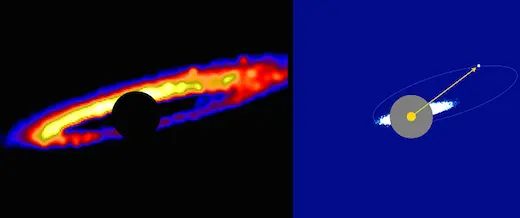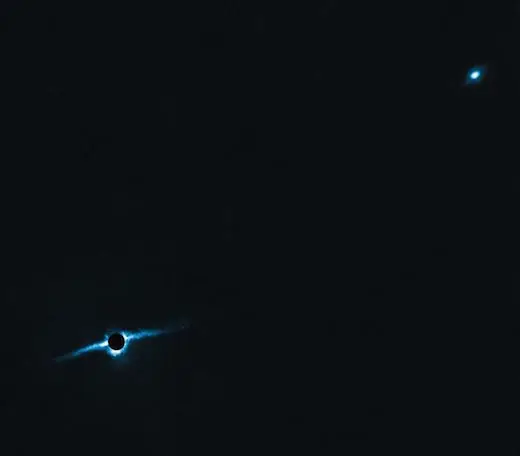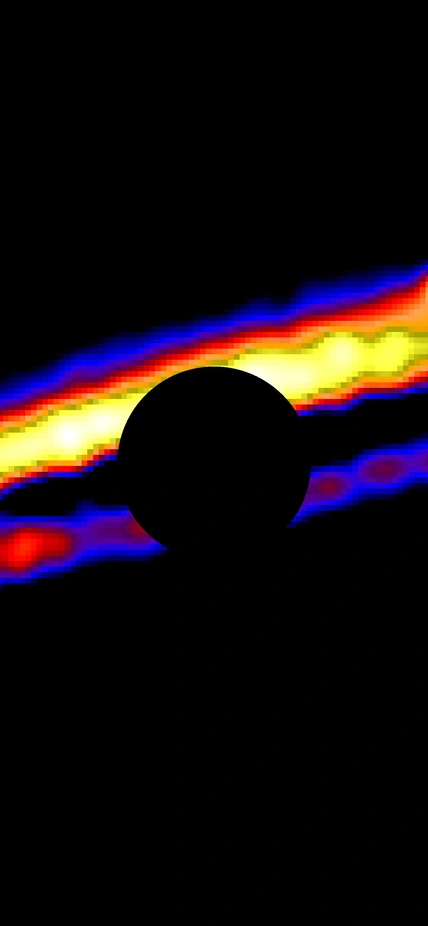Washington, DC—When planets first begin to form, the aftermath of the process leaves a ring of rocky and icy material that’s rotating and colliding around the young central star like a celestial roller derby. Analogs to our own Solar System’s Kuiper Belt, these disks of debris left over from planet formation can be detected by astronomers and studied to help understand the processes that create planetary systems.
Determining how the gravity of existing planets influences a disk’s architecture is one important area of study. Most of this research focuses on how planets that exist inside the debris disk define its shape, which is one of the few disk characteristics that can be directly observed from Earth. New work led by Carnegie’s Erika Nesvold looks at how a disk is affected by a planet that exists beyond its outermost edge, and demonstrates that the disk’s shape can indicate whether the planet formed beyond the disk, or initially existed inside of the disk and moved outward over time. The work is published by The Astrophysical Journal Letters.
The star HD 106906 is perfect for studying this phenomenon. It has one giant planet, about 11 times the mass of Jupiter, orbiting very far away from its host star, at least 650 times the distance between the Earth and our own Sun. This planet, HD 107906b, orbits outside of its star’s debris disk, which is about ten times closer to the star than it is.
Nesvold and her colleagues, Smadar Naoz and Michael Fitzgerald of UCLA, modeled the HD 106906 system to better understand how an outside planet affects the structure of a debris disk.
“We were able to create the known shape of HD 106906’s debris disk without adding another planet into the system, as some had suggested was necessary to achieve the observed architecture,” Nesvold said.
The single, distant giant planet’s gravity was able to affect the debris in just the right way to produce the system’s flat, non-circular ring and to account for the disk’s observed shape and features.
What’s more, Nesvold’s model was able to help her and the team better understand the orbit and likely formation history of the planet HD 106906b. The team’s results indicate that, counter to some predictions, it’s likely that the planet formed outside of the disk. If the planet had formed inside the disk and moved outward, the disk would have taken on a different shape than the one that astronomers can see in the system.
“Other debris disks that are shaped by the influence of distant giant planets are probably likely,” Nesvold added. “My modeling tool can help recreate and visualize how the various features of these disks came to be and improve our understanding of planetary system evolution overall.”

Caption: Two images of the HD 106906 stellar system created by Erika Nesvold and her team’s simulation. The left panel shows a zoomed-in image of the ring of leftover rocky and icy planet-forming material that is rotating around the star. (The star is masked by the black circle.) The different hues represent gradients of brightness in the disk material. (Yellow is the brightest and blue the dimmest.). The right panel shows a farther-out view of the simulated system. The star is represented by the yellow circle with an arrow pointing to the exoplanet, 106906b. Nesvold’s team demonstrated that the exoplanet is shaping the structure of the debris disk, which is shown by the white and blue dots encircling the star.

Caption: This is an actual observation of HD 106906 taken by the European Southern Observatory’s planet-finding tool SPHERE. The star is blacked out by a circle (which masks its glare from blinding the instrument) and the debris disk can be seen in the lower left. In the upper right is the exoplanet, 106906b. The simulation created by Erika Nesvold and her team accurately recreated the observed characteristics of the disk: the disk is brighter on its eastern (left) side, and oriented about 20 degrees clockwise from the planet's position on the sky. This image is courtesy of ESO and A.M. Lagrange of Université Grenoble Alpes.
__________________
This work was supported by a Carnegie DTM postdoctoral fellowship and a Sloan Foundation fellowship.
